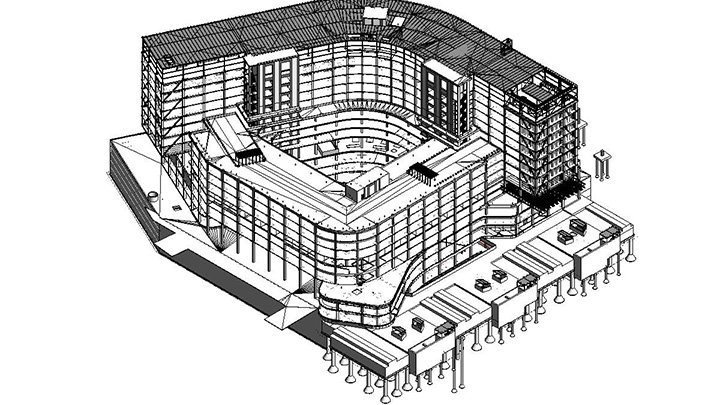

During design and construction, design briefs helped share a quick glance at different aspects of the building. It also explains where feedback was used to make the centre even more welcoming and comforting for patients.
A brief description is below.
The centre has more than 6,200 square metres of outdoor accessible spaces, ensuring patients, families, visitors and staff can connect with nature and heal in a relaxing environment.
At the heart of the centre, a ground-floor outdoor courtyard will provide natural light throughout the facility and a calming fresh environment that staff, visitors and patients can access.
There is also green space with both staff and patient access on the 8th floor. The watering of plants is efficient, saving approximately 66% more potable water per year as compared to conventional landscaping designs – that is more than 700,000 litres of water per year.
The centre will save more than 34 million litres of water each year due to water efficient washroom fixtures such as low flow showers, toilets, urinals, lavatories, and kitchen sinks. These savings will be roughly equivalent to 14 Olympic sized swimming pools.
The building will operate 26% more efficiently than a similar sized commercial building.
High efficiency filtration will also be used to remove particulates from the air, and the HVAC system - designed to use 100% fresh air- ensures that air within the facility is not recycled, further reducing the risk of airborne transmissible diseases.
The Arthur Child has been awarded LEED Gold certification.
LEED, or Leadership in Energy and Environmental Design, is a globally recognized green building certification system developed by the U.S. Green Building Council (USGBC). The certification provides a framework for healthy, highly efficient, and cost-saving green buildings. Achieving LEED Gold status means the building has met rigorous standards across various categories such as sustainability, water efficiency, energy and atmosphere, materials and resources, and indoor environmental quality.
Achieving LEED Gold certification, the Arthur Child sets a new standard for healthcare facilities. This certification recognizes our excellence in areas such as energy efficiency, water conservation, and indoor environmental quality. It reflects our dedication to creating a healthy and sustainable environment for patients and staff alike. Read more.
The Connector is an elevated and enclosed 400m pathway that will accommodate the flow of people and materials between the cancer centre and other buildings on the Foothills Medical Centre (FMC) site. It also provides a route for infrastructure connections such as a pneumatic tube system. The structure includes areas of respite and seating, and the space for a small retail outlet.
Automatic Guided Vehicle System – Self-guided carts that travel on a preset path and carry food or supplies throughout the building.
Dynamic Glass – External windows with a built-in system which enables windows to change tint on a pre-programmed schedule or via manual controls.
MR-Linac Machines – The centre has two MR-Linac machines, technology that delivers radiation while simultaneously obtaining high-contrast and high- resolution magnetic resonance imaging (MRI), enabling radiation oncologists to deliver more precise radiation to tumours that move with respiratory motion, or to tumours that are close to healthy organs that need to be avoided. This will result in better tumour control and fewer side effects from radiation.
Robotic IV Automation (KIRO) Systems – There are two robotic IV automation systems that automatically prepares medications for syringes and IV bags in a sterile environment, which improves patient safety by ensuring accuracy and reducing possible contamination. These are the first units that have ever been installed in Canada.
Medical Physics 3D Metal Printers – Multiple types of 3D printers will be used by the Medical Physics team including, metal, carbon-fiber, and standard polymer. These allow for the team to create an array of parts that can be used for many things like patient-specific 3D Bolus (material used to reduce or alter dosing) for targeted radiation therapy.
The building was designed to provide a collaborative and innovative environment that will bring state-of-the-art care and research together. The research space at Arthur Child is larger than the footprint of the entire Tom Baker Cancer Centre.
Some of those features include: